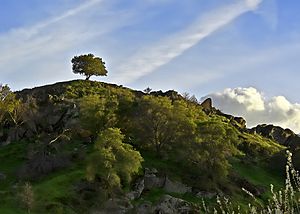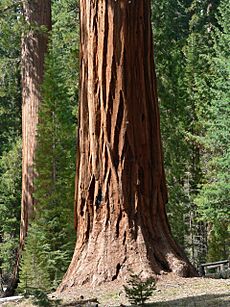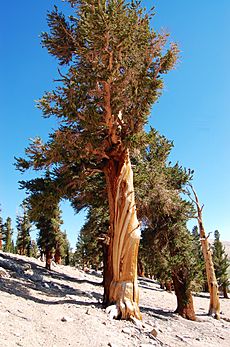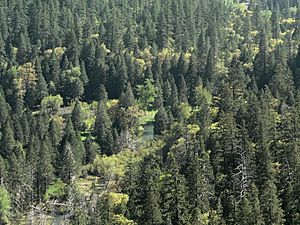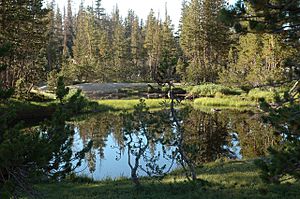Ecology of the Sierra Nevada facts for kids
- See Sierra Nevada for general information about the mountain range in the United States.
Quick facts for kids Sierra Nevada forests |
|
|---|---|
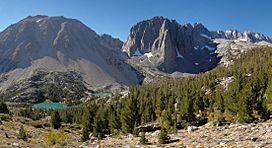
Subalpine forest at the base of Temple Crag
|
|
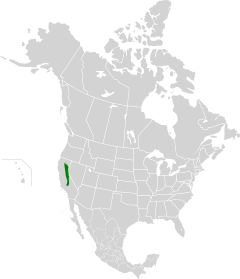 |
|
| Ecology | |
| Realm | Nearctic |
| Biome | Temperate coniferous forests |
| Bird species | 197 |
| Mammal species | 103 |
| Geography | |
| Country | United States of America |
| State | California, Nevada |
| Conservation | |
| Global 200 | Yes |
| Habitat loss | 1.0785% |
| Protected | 72.55% |
The ecology of the Sierra Nevada is super diverse and complex! This amazing mountain range is found in the U.S. states of California and Nevada. The mix of climate, mountains, moisture, and soils creates many different natural areas. These areas change as you go higher up, from about 500 feet (150 meters) to 14,500 feet (4,400 meters).
You can find different life zones here. They range from scrub and chaparral plants at lower elevations to subalpine forests and alpine meadows high up. These zones often form "belts" that stretch along the Sierra Nevada. There are many hiking trails and public lands where you can explore these different biomes and ecosystems.
The western and eastern sides of the Sierra Nevada are quite different. The eastern side is in a "rain shadow," meaning it gets much less rain. Because of this, plants and animals on the east side are used to much drier conditions. The heights mentioned for these zones are for the central Sierra Nevada. These zones can shift by about 1,000 feet (300 meters) from the north to the south end of the mountains.
Contents
Exploring Western Life Zones
The western side of the Sierra Nevada has several distinct life zones, each with its own unique plants and animals.
Foothill Woodland and Chaparral Zone
This is the lowest zone in the Sierra Nevada, found near the Central Valley. It stretches from about 500 feet (150 meters) to 3,500 feet (1,050 meters) high. Summers here are hot and dry, with little to no snow in winter.
The foothills have lots of grasslands, often with non-native grasses. You'll also see savanna areas where grasslands mix with woodlands. Common trees include blue oak and gray pine. There are also chaparral areas with dense shrubs. Many plants here are similar to those found in the California Coast Ranges.
Animals you might spot include black bears, ringtail cats, coyotes, gray squirrels, bobcats, California mule deer, and skunks.
Lower Montane Forest

Starting around 3,000 feet (900 meters) up, you enter the lower montane forest. This zone has hot, dry summers and cool, wet winters, typical of a Mediterranean climate. It's also called the yellow pine forest zone.
It's common for several feet of snow to fall here in winter and stay on the ground for months. This forest is beautiful and interesting because of its many different tree species. The main trees here are the ponderosa pine and the Jeffrey pine. Ponderosa pines are usually on the west side, while Jeffrey pines are on the east.
Other trees include California black oak, sugar pine, incense-cedar, and white fir. Animals you might see are the dark-eyed junco, mountain chickadee, western gray squirrel, mule deer, and American black bear. The endangered Yosemite toad lives in this zone in the central Sierra Nevada, from about 4,800 feet (1,460 meters) to 11,900 feet (3,630 meters).
The lower montane forest changes a bit depending on where you are.
- North of Grass Valley, it's from 2,000 to 4,000 feet (600 to 1,200 meters) and has more Douglas-fir and less ponderosa pine.
- In the middle Sierra, south to the Merced River, it's at the same height, but it's drier, so the forest mixes with chaparral.
- In the southern Sierra, it's from 3,000 to 5,000 feet (900 to 1,500 meters), sometimes up to 6,000 feet (1,800 meters). Ponderosa pine is very common here, and the ground is mostly granite.
Mid-Montane Forest
The mid-montane forest grows on the western slopes at medium heights.
- North of Lake Tahoe, it's from 3,000 to 6,000 feet (900 to 1,800 meters).
- Between Tahoe and Yosemite, it's from 4,000 to 6,000 feet (1,200 to 1,800 meters).
- South of Yosemite, it's from 5,000 to 7,000 feet (1,500 to 2,100 meters).
This zone has a mix of trees like white fir, Coast Douglas-fir, ponderosa pine, Jeffrey pine, live oak, black oak, and tanoak. North of Tahoe, you'll see more white fir and Douglas-fir. Jeffrey pine grows in special lava soils. In Yosemite and areas south, you can find amazing giant sequoia trees in wetter spots.
Upper Montane Forest
The upper montane forest starts around 7,000 feet (2,100 meters). Here, summers are short, moist, and cool, while winters are cold and very wet. Snow starts falling in November and can pile up to 6 feet (1.8 meters) deep, sometimes staying until June!
You'll find pure groups of red fir and lodgepole pine here; these are the main trees for this forest. Jeffrey pine, which has bark that smells like vanilla, and the beautiful western juniper also grow in this zone. Wildflowers bloom in meadows from June to August.
Common animals include the hermit thrush, dusky grouse, great grey owl, golden-mantled ground squirrel, and sometimes the marten. You can see these forests from Tioga Pass Road (east of Crane Flat), Glacier Point Road, and State Route 108.
The height of this zone changes with latitude:
- North of Yosemite, it's from 6,000 to 8,000 feet (1,800 to 2,400 meters).
- To the south, it's from 7,000 to 9,000 feet (2,100 to 2,700 meters).
Subalpine Forest
The subalpine forest takes over around 9,000 feet (2,700 meters). The climate here is even colder, with a very short growing season because of long, cold, snowy winters. Snow can pile up from 3 to 9 feet (1 to 2.5 meters)!
The most common tree is the whitebark pine. You'll also find western white pine, mountain hemlock, and lodgepole pine. Many subalpine meadows are here, full of flowers from July to August. Many animals, like Clark's nutcracker, live in or visit this zone.
The harsh climate, with lots of snow and wind, shapes the plants and animals here. Soils are thin and don't have many nutrients. Because of these tough conditions, plants grow slowly. This zone is very sensitive to environmental changes like climate change and pollution.
- South of Bridgeport, this forest is from 9,000 to 11,000 feet (2,700 to 3,350 meters) and has foxtail pines.
- To the north, it's from 8,000 to 10,000 feet (2,400 to 3,000 meters), and foxtail pines are not found there.
Alpine Zone
The alpine zone starts around 10,500 feet (3,200 meters) in the southern Sierra and 9,000 feet (2,700 meters) in the north. You can easily tell this zone apart because it's above the tree line. No trees grow here due to the very harsh weather.
Summers are short and cool, while winters are long, cold, and snowy. There are many exposed granite rocks, rocky slopes, and boulder fields, which limit how much plant life can grow. The plants here, like cushion plants, grasses, willows, and sedges, must flower and produce their seeds quickly during the short, frost-free summer.
Some animals that live here include the American pika, Belding's ground squirrel, the yellow-bellied marmot, and the endangered Sierra Nevada bighorn sheep. You can explore this zone by hiking or climbing to the high peaks of the Sierra.
Eastern Life Zones
The four highest life zones on the eastern side of the Sierra Nevada are similar to the western zones. However, they are found at higher elevations because they get less rain. In the Central Sierra, these zones are:
- Alpine zone: 11,500 feet (3,500 meters) and above
- Subalpine forest: 10,500 to 11,500 feet (3,200 to 3,500 meters)
- Upper montane forest: 9,000 to 10,500 feet (2,700 to 3,200 meters)
- Lower montane forest: 7,000 to 9,000 feet (2,100 to 2,700 meters) (mostly Jeffrey pines).
In the Owens Valley, the Foothill Woodland Zone is replaced by a Pinyon-Juniper Woodland Zone. This area has single-leaf pinyon pines and sierra junipers. The ground is covered with big sagebrush and blackbrush. Jeffrey pines might grow along streams. Animals like the pinyon jay and the desert bighorn sheep live here. This zone goes down to 5,000 feet (1,500 meters).
Below 5,000 feet (1,500 meters), there isn't enough rain for trees. These lower zones are the Sagebrush Scrub Zone, Saltbush Scrub Zone, and the Alkali Sink Zone. They are different based on how salty the soil is.
What Threatens the Sierra Nevada?
Non-Native Plants in Yosemite National Park
Yosemite National Park has found over 130 types of non-native plants. These plants were brought to Yosemite by early settlers in the late 1850s. Things like wildfires and construction have helped these non-native plants spread quickly.
Many of these plants aggressively take over and push out the native plants. This can harm the park's natural resources. Non-native plants can change the park's ecosystems. For example, some might increase how often fires happen or add more nitrogen to the soil, which helps even more non-native plants grow. Many non-native species, like yellow starthistle, have long roots that help them get more water than native plants.
Some plants like Bull thistle, common mullein, and Klamath weed have been known as harmful pests in Yosemite since the 1940s. More recently, other aggressive plants needing control include yellow starthistle, sweet clovers, Himalayan blackberry, cut-leaved blackberry, and periwinkle (Vinca major).
Lodgepole Needle Miner
The lodgepole needle miner (Coleotechnites milleri) is a tiny insect. It lives mostly in the needles of lodgepole pine trees for two years. Then, it turns into a small gray moth for a few weeks in July of odd-numbered years. This pattern makes it hard for predators to control their numbers, so their populations can grow very fast.
There have been many outbreaks of these insects throughout history. Records show outbreaks from 1903 to 1921, 1933 to 1941, and 1947 to 1963. You can still see large areas of "ghost forest" (dead trees) in the Sierra Nevada from past outbreaks.
Scientists started watching the lodgepole needle miner in 1966. The current outbreak began in 1973 and has spread across about 40,000 acres (160 square kilometers). Each year, nearly 10,000 acres (40 square kilometers) of trees die or are severely damaged.
Wildfires are common in lodgepole pine areas, but they usually stay small. Fire suppression efforts haven't changed these forests much. In the Sierra Nevada, the needle miner plays a bigger role in the health of lodgepole pine forests than fire does.
Special Plants and Animals
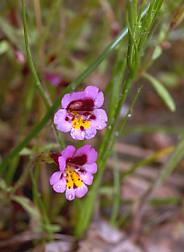
The Sierra Nevada is home to at least 1,300 types of vascular plants (plants with tubes for water), plus many mosses and lichens. There are also at least 450 types of vertebrate animals (animals with backbones). A total of 135 plant species in the Sierra Nevada are considered Threatened, Endangered, or Sensitive.
Here are some rare plants that are a concern for the U.S. government:
- Three-bracted onion
- Yosemite woolly sunflower
- Congdon's lomatium
- Tiehm's rock-cress
- Slender-stemmed monkeyflower
- Bolander's clover
These species are watched and managed to prevent them from becoming endangered.
Four rare plant species that are very limited in their range in California are:
Endangered or threatened animal species found in the Sierra Nevada include:
- Sierra Nevada bighorn sheep (endangered since 2000)
- California condor (endangered since 1967)
- Southwestern willow flycatcher (endangered since 1995)
- Paiute cutthroat trout (threatened since 1975)
- Lahontan cutthroat trout (threatened since 1975)
- Owens Tui chub (endangered since 1985)
Wetlands in the Sierra Nevada
Wetlands in the Sierra Nevada are found in valley bottoms. They are often connected to nearby lakes and rivers by seasonal flooding and groundwater movement. Meadow habitats, found from 3,000 to 11,000 feet (900 to 3,350 meters), are usually wetlands. So are the riparian habitats along streams and rivers.
The Sierra has three main types of wetlands:
- Riverine
- Lacustrine
- Palustrine
Each type is different in where it's found, how long it's wet, what plants grow there, and how it helps the ecosystem. All three types provide rich homes for plants and animals. They also help slow down and store floodwaters, reduce erosion downstream, and improve water quality.
Riverine wetlands are found in river and stream channels. They are greatly affected by seasonal water flow. When flooded, they provide homes for water-loving plants like willows and aquatic animals like tadpoles and young fish.
Lacustrine wetlands are usually found on river floodplains and along lakeshores. They are affected by seasonal changes in groundwater levels. These wetlands are rare in the mountains, but they support many plants and animals that like warm water.
Palustrine wetlands are different because they have very dense covers of trees, shrubs, or other plants sticking out of the water. This type includes wet meadows, thick riparian habitats, and shallow ponds. They provide cover and food for wildlife moving between dry land and water habitats.
Since the 1970s, the United States has made great progress in protecting and restoring wetlands. All federal land in the Sierra Nevada follows a rule from 1990 that says there should be 'no net loss' of wetlands. This means federal agencies must map and protect all existing wetlands.
In 1996, the United States Fish and Wildlife Service mapped and classified some Sierra Nevada wetlands, including all of Yosemite National Park. This was done using aerial photographs and topographic maps as part of the National Wetlands Inventory Web Site (NWI). These NWI maps are not perfectly accurate and only show wetlands larger than 5 acres (2 hectares).
The National Park Service works to restore wetlands that were drained or filled in the past. For example, in Yosemite Valley, the Cook's Meadow restoration project filled old drainage ditches and removed an old road that was blocking water flow. These efforts are being watched to see how successful they are at bringing the wetlands back to their natural state.


